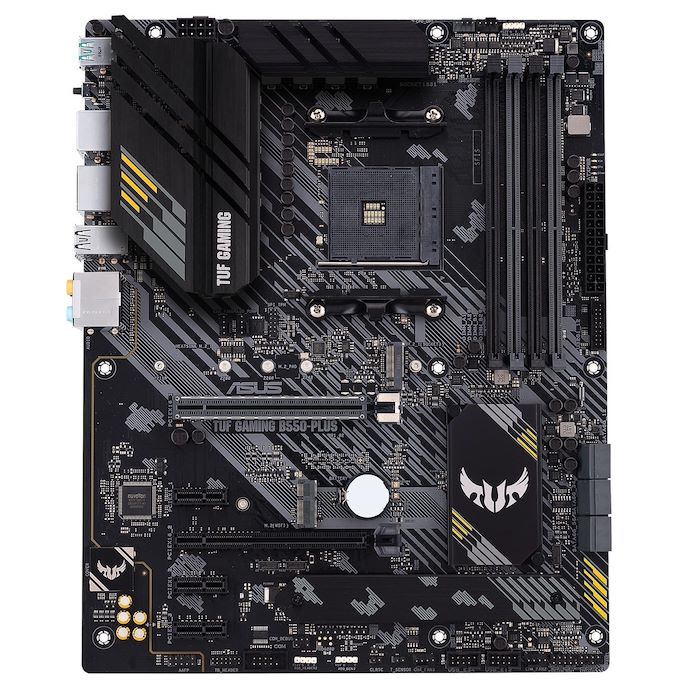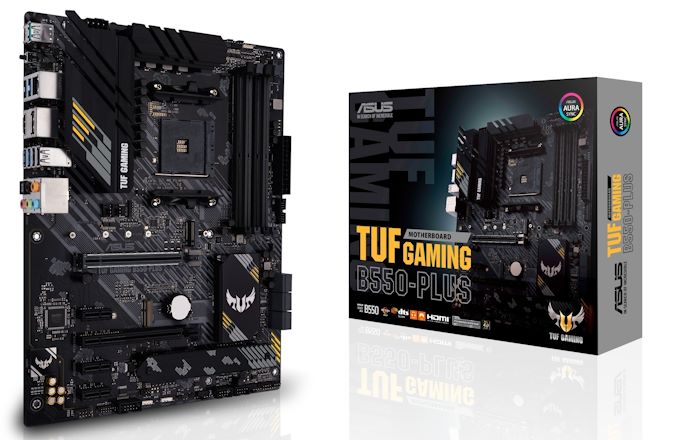The AMD B550 Motherboard Overview: ASUS, GIGABYTE, MSI, ASRock, and Others
by Dr. Ian Cutress & Gavin Bonshor on June 16, 2020 11:00 AM ESTASUS TUF Gaming B550-Plus
In days of old, ASUS’ TUF ‘The Ultimate Force’ motherboards were a byword for rigidity, offering five years warranty over the standard three, and the more premium models were built with full scale motherboard armor and dust covers to survive harsh environments. In recent generations, the TUF brand has been whittled down to a logo and some yellow stripes, and sits below the Strix brand, which itself used to be the budget brand.
For the TUF Gaming B550-Plus, we get an above average motherboard on the specifications. The power delivery heatsink is spread across two sides of the socket, but there isn’t really a rear IO cover of sorts. There is a single 8-pin power socket at the top, and these is where the aesthetic starts – a series of grey lines going from one corner of the motherboard PCB to the other, with some hellow thrown in for TUF.
The socket area has access to four 4-pin fan headers, two above and two below the socket. There are four DRAM slots in alternating colors, each with single side latches despite the first PCIe slot being quite a distance away. On the right hand side of the board there is an RGB header, a 24-pin ATX connector, a USB 3.0 header, and six SATA ports.
For the PCIe area, we start with the PCIe 4.0 x4 M.2 slot, which doesn’t have a heatsink (presumably so users can have their own). Underneath is the PCIe 4.0 x16 slot from the CPU. The other full length slot is a PCIe 3.0 x4 from the chipset, which is just above the PCIe 3.0 x4 M.2 slot from the chipset as well. The chipset heatsink isn’t anything substantial, but certainly enough for the job.
At the bottom of the board we have the audio subsystem (S1200A without additional amps), a Thunderbolt header, a COM port, RGB headers, a Clear CMOS header, a thermocouple header, two 4-pin fan headers, and two USB 2.0 headers.
On the rear panel we have a USB 3.2 Gen 2 Type-A, a USB 3.2 Gen 2 Type-C, a USB Flashback button, a 2.5 gigabit Ethernet port (Realtek RTL8125B), four USB 3.2 Gen 1 ports, a DisplayPort, a HDMI port, two USB 2.0 ports, and the audio jacks.













101 Comments
View All Comments
Operandi - Tuesday, June 16, 2020 - link
Looks like some nice mATX versions this round, nice!YB1064 - Thursday, June 18, 2020 - link
I was hoping to see a $75-$90 board.kenjiwing - Tuesday, June 16, 2020 - link
Fortunately, this component is a unique motherboard among B550 and well worth reading up on [add link].Needs to be edited.
anirudhs - Tuesday, June 16, 2020 - link
There's a noise sensor which can adjust fan speed for maximum quietness with good thermals. Saw it on the KitGuruTech video. The noise sensor isn't there to spy on you though.PeterCollier - Wednesday, June 17, 2020 - link
The quality of the editing here is shit tier. Seriously, just run the articles through Grammarly before publication. It's free and it spots plenty of errors.Heavenly71 - Tuesday, June 16, 2020 - link
Sadly none of the mITX boards have more than 6 external USB ports. My old ASUS mITX has 8! And in really small mITX cases you can't add a bracket with more USB, because the two brackets are already used by the gfx card. Guess I have to wait for an enthusiast mITX board )-:damianrobertjones - Tuesday, June 16, 2020 - link
Or, just maybe, get a usb dongle with 4 ports?Mr Perfect - Tuesday, June 16, 2020 - link
That is disappointing. The number of USB devices people need to plug in can't be dropping, surely? I know I've got more now then even a year ago.rrinker - Tuesday, June 16, 2020 - link
Are they really going up? I have 2 USB devices plugged in to my system - a keyboard and a mouse. I occasionally plug a USB stick in one of the front ports to transfer files. My phone and tablet sync over wifi, they don't get plugged in. I have a charger behind my desk and a cable to charge them. My printer is on the network.The one place I DO need lots of USB ports is also the place where I have a small cube case machine, with no discreete GPU, because it doesn;t need one. On that one I added a USB PCI card to get enough ports. In addition to the keyboard and mouse, that machine is on my workbench where it connects to several electronic test instruments and I have multiple cabled for programming microcontrollers. I also have a USB microscope for board inspection. And then I have 3 more USB devices connected for my other hobby that shares the bench. Plus a front port kept free for USB sticks.
So the use case I have for more USB has the PCI slots open to add expansion cards, the use case where I have a discrete GPU eating up the slot space doesn't need an excess of USB ports.
DigitalFreak - Tuesday, June 16, 2020 - link
I use 3 USB 3.0 ports just for my Oculus Rift